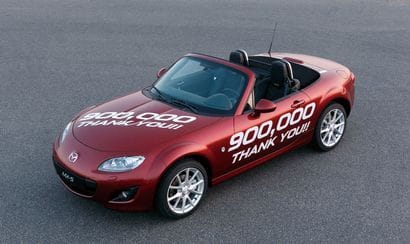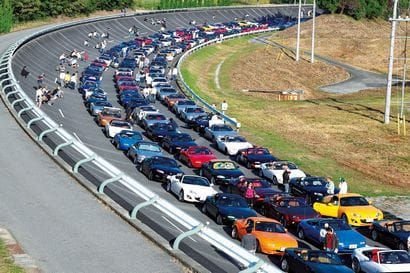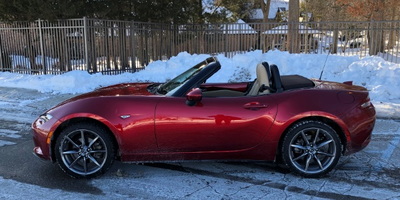The iconic MX5 Miata hits the 900,000 production milestone
 Dark times
Dark times
It all began 22 years ago this month in the Windy City, when the first generation Mazda Miata was unveiled to the world at the 1989 Chicago Auto Show.
To appreciate the impact of the Miata’s introduction, you have to understand what the state of affairs of the lightweight, low-cost two seat sports car market was back then. To quote the Harry Potter character Hagrid, “It was dark times, Harry, dark times.”
The list of small, affordable 2-seat sports cars that followed the trail blazed by American GIs returning home from Europe and entertained American drivers from the early 1950’s had largely disappeared by 1985.
The Austin-Healy Sprite ceased production in 1969. It was followed by the Triumph GT6 in 1971, the original Lotus Elan in 1973, the MG Midget in 1979, the Triumph Spitfire and MGB in 1980, Triumph’s TR7 and TR8 models in 1981 and the Fiat 124 Sport Spyder in 1985.
 Love and hate
Love and hate
To be sure, owning any one of the aforementioned vehicles required dealing with the love-hate relationship that was required. When they worked, the planets aligned and all was good in the world. Quite often, however, they ceased to function.
Owning one meant you had to deal with vehicle electrics engineered by the British firm Lucas which was given label by car owners “the prince of darkness.” I, myself, owned a 1964 MGB. It was British Racing Green and, among other idiosyncrasies, featured an electrical system fed from 2 6-volt batteries located in a storage cubby under a removable panel behind the seats (I could see there was no room for it in the engine compartment, but why 2 6-volt batteries when you could just as easily use one 12-volt?).
Their engines leaked oil, heaters blew air that was barely warm and the bodies would literally rust before your eyes. Even with all this, they made top-down driving on summer evenings seem magical and racing around a road course the second best thing in life.
 The Miata
The Miata
The Mazda Miata bust on the scene in 1989 promising Colin Chapman-esque lightness and Japanese reliability. It was solid; fun to drive, and it soon endeared itself to a whole new generation of sports car drivers.
 The original Miata was equipped with a 1.6-liter, inline four-cylinder engine producing 116 horsepower and 100 lb-ft of torque. A removable hardtop was an option and the initial color choices were red, white and blue. With a starting price of $14,000, Mazda found itself unable to meet initial demand.
The original Miata was equipped with a 1.6-liter, inline four-cylinder engine producing 116 horsepower and 100 lb-ft of torque. A removable hardtop was an option and the initial color choices were red, white and blue. With a starting price of $14,000, Mazda found itself unable to meet initial demand.
In 1997, Mazda unveiled a redesigned second generation model, while the Geneva Motor Show in 2005 saw the unveiling of the current third gen Miata.
 Third generation Miatas are equipped with the company’s MZR-series 2.0-liter, inline four-cylinder engine that produces 167 horsepower (158 with the automatic) and 140 lb-ft of torque. Soft-topped Sport models start at $23,110 with the top-level, retractable hard top Grand Touring model starting at $28,550.
Third generation Miatas are equipped with the company’s MZR-series 2.0-liter, inline four-cylinder engine that produces 167 horsepower (158 with the automatic) and 140 lb-ft of torque. Soft-topped Sport models start at $23,110 with the top-level, retractable hard top Grand Touring model starting at $28,550.
 By the numbers
By the numbers
Mazda marked 1999 by producing the 500,000th Miata and in 2000 it was recognized as the world’s top-selling sports car by Guinness. Mazda added to that tally by an additional 100K in 2002, 2005 and 2007, and yesterday Mazda made it official – the 900,000 Miata rolled down the production line. It is the quintessential Miata - a soft-top 6-speed manual in copper Red and destined for Germany.
"Since Mazda launched the original MX-5, it has undergone two complete product redesigns and a series of upgrades," said Nobuhiro Yamamoto, MC program manager, MX-5. "Its enduring success is due to the strong support it enjoys from fans around the world, and I will strive to keep the MX-5's spirit alive while evolving it into a car that will be loved by even more people."
Sing it, brother.
 images courtesy of Mazda including the above shot of its 20th anniversary celebration
images courtesy of Mazda including the above shot of its 20th anniversary celebration












